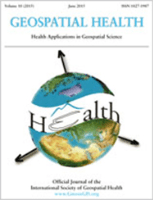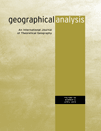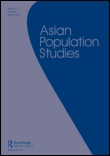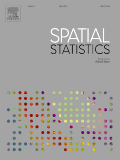
Spatial Demography
metrics 2024
Connecting People and Places through Rigorous Research
Introduction
Spatial Demography is a vital academic journal published by Springer International Publishing AG, focusing on the intersection of spatial analysis and demographic research. With its ISSN 2364-2289 and E-ISSN 2164-7070, this journal aims to advance understanding of population dynamics through innovative methodologies and spatially explicit data, offering a platform for researchers, professionals, and students engaged in demography, geography, and urban studies. While it does not currently operate under an open access model, Spatial Demography maintains a rigorous peer-review process to ensure high-quality publications that contribute significantly to the field. Given the growing importance of spatial data in demographic research, the journal serves as an essential resource for those looking to explore how spatial attributes influence demographic processes and patterns worldwide. The official address of the publisher is Gewerbestrasse 11, Cham CH-6330, Switzerland.
Metrics 2024
 -
- 1.10
1.10 1.70
1.70 -
-Metrics History
Rank 2024
IF (Web Of Science)
JCI (Web Of Science)
Quartile History
Similar Journals

Letters in Spatial and Resource Sciences
Empowering Scholars to Navigate Spatial ChallengesLetters in Spatial and Resource Sciences, published by Springer Heidelberg, is a prestigious journal dedicated to the interdisciplinary exploration of spatial and resource-related issues within the fields of demography, economics, geography, planning, and urban studies. Since its inception in 2008, this journal has provided a platform for cutting-edge research, facilitating the exchange of innovative ideas and methodologies that address contemporary challenges in spatial dynamics and resource allocation. With an impact factor reflecting its robust standing in academic circles (notably ranking Q2 in Demography and Geography, and Q3 in Economics and Econometrics as of 2023), it serves as an essential resource for scholars and practitioners alike. The journal is committed to fostering open dialogue and advancing the understanding of spatial phenomena, making it a vital asset for anyone engaged in these dynamic areas of study. Targeting a diverse audience, from researchers to industry professionals, it aims to enhance scholarly communication and promote evidence-based solutions to spatial and resource dilemmas.

Comparative Population Studies
Bridging gaps in population studies for informed policy-making.Comparative Population Studies is an esteemed open-access journal published by the BUNDESINSTITUT BEVOELKERUNGSFORSCHUNG in Germany, dedicated to advancing the field of demography. Since its launch and transition to open access in 2010, the journal has provided a platform for researchers to share innovative population studies, promoting a deeper understanding of demographic trends and patterns globally. With an impressive Q2 rank in Demography within the 2023 quartile categories and a commendable rank #61 out of 139 in Scopus' Social Sciences Demography classification, it plays a vital role in disseminating rigorous research. The journal covers a range of topics related to population dynamics, migration, and social implications, making it invaluable to academics, professionals, and students in the field. With an emphasis on comparative studies, Comparative Population Studies not only fosters scholarly dialogue but also enhances policy-making and economic planning. Located at Friedrich-Ebert-Allee 4, Wiesbaden 65185, Germany, the journal continues to be a prominent resource for those eager to engage with the latest demographic research.

Geospatial Health
Mapping Health: Where Geography Meets Well-being.Geospatial Health is an esteemed academic journal dedicated to the intersection of geography, health policy, and social sciences, published by UNIV NAPLES FEDERICO II. Since its inception in 2006, this Open Access journal has been pivotal in disseminating valuable research that examines health-related issues through a geographical lens. With an impact factor that places it in the Q3 category across multiple disciplines including Geography, Health Policy, and Medicine, it serves as a vital resource for researchers, practitioners, and scholars alike. Located in Naples, Italy, the journal aims to foster interdisciplinary collaboration and provide insights that can influence policy and practice in health and environmental sectors. With its commitment to accessibility and high-quality research, Geospatial Health continues to enrich the fields it represents, inviting contributions that explore the intricate dynamics between health and spatial determinants.

Hrvatski Geografski Glasnik-Croatian Geographical Bulletin
Elevating Geographical Scholarship for AllHrvatski Geografski Glasnik-Croatian Geographical Bulletin, ISSN 1331-5854, E-ISSN 1848-6401, is an esteemed open-access journal published by the Croatian Geographical Society that has been serving the geography community since 1929. Based in Zagreb, Croatia, this journal focuses on a broad spectrum of geographical research, providing a platform for the dissemination of original articles, reviews, and case studies that contribute to the understanding of earth-surface processes and development planning. Although it currently holds Q4 rankings in both Earth-Surface Processes and Geography, Planning and Development, the journal is dedicated to enhancing its impact within the scientific community, aspiring to elevate research visibility and collaborative opportunities. With a commitment to open access, it ensures that all content is readily available to researchers, professionals, and students worldwide, fostering an inclusive environment for geographical scholarship. Engaging with this journal presents an opportunity to stay updated with emerging trends and pivotal studies within the discipline throughout its converged years from 1998 to 2024, making it a vital resource in geography and related fields.

GEOGRAPHICAL ANALYSIS
Unveiling Insights into Spatial DynamicsGEOGRAPHICAL ANALYSIS, published by WILEY, is a premier scholarly journal that has been at the forefront of geographical and earth-surface research since its inception in 1969. With an ISSN of 0016-7363 and an E-ISSN of 1538-4632, this journal has established itself as an essential resource for researchers and professionals in the fields of Earth-Surface Processes and Geography, Planning and Development, achieving impressive rankings of 13th and 60th in their respective categories according to Scopus, placing it in the Q1 quartile for both. The journal is renowned for its rigorous peer-reviewed articles that contribute valuable insights into spatial analysis, environmental impacts, and urban planning, thus fostering a deeper understanding of geographical phenomena. With access options available through traditional subscriptions, GEOGRAPHICAL ANALYSIS continues to serve as a critical platform for the dissemination of cutting-edge research and innovative methodologies, ultimately shaping the future of geographical inquiry and application.

Asian Population Studies
Unveiling Insights into Demographic TrendsAsian Population Studies is a distinguished journal published by Routledge Journals, Taylor & Francis Ltd, delivering comprehensive insights into the vibrant field of demography. Since its inception in 2006, this peer-reviewed journal has consistently provided a platform for high-quality research that enhances our understanding of population dynamics in Asia. With an impressive category ranking of Q2 in Demography for 2023, and holding a notable position as 35th out of 139 within the Scopus ranking, it is recognized for its significant contributions to the field, appealing to researchers, scholars, and professionals alike. The journal covers a diverse range of topics, including population growth, migration patterns, and socio-economic factors influencing demographic changes across Asian countries. Although it does not offer open access, Asian Population Studies remains a vital resource for those seeking to explore demographic trends and their implications for policy and practice in one of the most populous regions of the world. With a commitment to academic excellence, it continues to serve as an essential tool for anyone engaged in demographic research and study.

Spatial Statistics
Empowering Decision-Making through Spatial InsightsSpatial Statistics is a premier journal published by ELSEVIER SCI LTD, focusing on innovative methodologies and applications in the realm of statistical analysis within spatial contexts. With an ISSN of 2211-6753, the journal has established itself as a significant contributor in its field since its inception in 2012, and continues to thrive, with its next volume projected through 2024. It holds a respectable Q2 ranking across several categories, including Computers in Earth Sciences, Management, Monitoring, Policy and Law, and Statistics and Probability, affirming its impact and relevance to researchers and professionals alike. The journal's commitment to publishing high-quality research enables scientists to advance understanding of spatial phenomena, facilitating informed decision-making in various applications ranging from environmental science to urban planning. As part of a robust academic community, Spatial Statistics invites submissions that push the boundaries of conventional statistical techniques, ensuring that the latest findings contribute significantly to the discipline's body of knowledge.

JOURNAL OF POPULATION ECONOMICS
Pioneering Research at the Intersection of Demography and EconomicsThe JOURNAL OF POPULATION ECONOMICS, published by SPRINGER, stands as a leading peer-reviewed journal in the fields of demography and economics. Established in 1988, this esteemed journal offers a platform for high-quality research that probes the intricate relationships between population dynamics and economic phenomena. With its impressive Q1 quartile ranking in both Demography and Economics and Econometrics for 2023, the journal is recognized as a vital resource for scholars and practitioners alike, reflecting its rigorous standards and impact in the academic community. Its Scopus rankings position it within the top tiers of social sciences, making it an essential read for those engaged in demographic and economic research. Although the journal does not currently adopt an open access model, its esteemed reputation and continuous publication until 2024 ensure relevant and up-to-date findings contribute meaningfully to scholarly discourse. At its core, the JOURNAL OF POPULATION ECONOMICS aims to bridge theoretical insights and empirical findings, fostering an understanding of how population changes influence economic outcomes and vice versa.

Spatial Information Research
Pioneering research at the crossroads of AI and geography.Spatial Information Research, published by SPRINGER SINGAPORE PTE LTD, is a prominent journal committed to advancing the interdisciplinary field of spatial information science. With an ISSN of 2366-3286 and an E-ISSN of 2366-3294, this journal serves as a crucial platform for disseminating research findings from 2016 to 2024, focusing on applications in Artificial Intelligence, Computer Science Applications, and Geography, among others. Ranking in the Q2 and Q3 quartiles across various categories, it showcases impactful research that informs geographic planning, environmental sciences, and computational methodologies. The journal's rigorous peer-review process ensures high-quality contributions that offer insights for both academic scholars and industry professionals. While retaining exclusive access options, Spatial Information Research is a vital resource for researchers eager to explore the complexities of spatial data and its applications in real-world scenarios.

European Journal of Population-Revue Europeenne de Demographie
Connecting Scholars to the Heart of DemographyWelcome to the European Journal of Population-Revue Europeenne de Demographie, a premier scholarly publication dedicated to advancing the field of demography. Published by Springer since 1985, this journal has established itself as a vital resource for researchers, professionals, and students interested in population studies, evidenced by its Q1 ranking in Demography for 2023 and a notable Scopus ranking within the top 20% of its category. With an ISSN of 0168-6577 and an E-ISSN of 1572-9885, the journal provides a platform for high-quality, peer-reviewed research, contributing to the understanding of population dynamics and demographic trends across Europe and beyond. Although currently not open access, the journal ensures broad mobility of knowledge through diverse access options, aspiring to bridge theoretical insights and practical applications crucial for policy-making and societal engagement. Join us in exploring the intricate tapestry of demographic data as we examine pressing issues such as migration, fertility, mortality, and population aging in an ever-evolving global context.